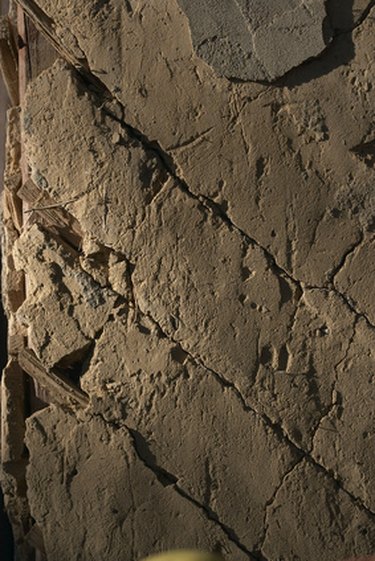Things You'll Need
Plastic drop cloths
Protective clothing
Respirator mask
Safety glasses
Hammer
Sledgehammer
Pry bar
Wet-dry vacuum or broom

Horse-hair plaster is a type of wall covering commonly found in older homes. In the past, homebuilders mixed hair into plaster in order to give it strength. Then they would spread the plaster over lathing, a latticework of closely placed strips of wood. The plaster would squeeze into the lathing before drying. The installers then finished the job by applying several coats of thin plaster until the surface of the wall or ceiling had a smooth polish. To remove the plaster, separate the dried plaster from the lathing.
Step 1
Seal off the area with plastic drop cloths from floor to ceiling. Plaster dust is fine and pervasive, so closing off the work area saves time in cleaning and dusting off every surface in the home. Also, keep windows and doors closed during the project. Breezes and cross ventilation only spread the dust farther.
Video of the Day
Step 2
Put on old clothing, a hat, gloves, a respirator mask and safety glasses. The more body area you cover, the easier your cleanup is later. Use a respirator mask that is approved for use with fine particulates like plaster dust.
Step 3
Turn off all electrical power to the room in case there are buried wires in the horse-hair plaster.
Step 4
Use a hammer to break a hole in the horse-hair plaster. Then use gloved hands to remove the large chunks that break away. If the plaster proves difficult to shatter, use a large sledgehammer to pound the plaster until it cracks and breaks.
Step 5
Use a pry bar to separate large chunks of plaster from the lathing. To do this, work the end of the pry bar in between the plaster and the wood lathing. Leverage the plaster away from the wall. Note that smaller chunks are typically easier to dispose of, so they may have to be broken up into large pieces.
Step 6
Dispose of the debris after removing all the plaster. Sweep up or use a wet-dry vacuum to remove as much dust as possible. Then allow the kicked-up dust to settle for 24 hours before vacuuming again.
Step 7
Take down and dispose of the plastic drop cloths that are used to separate the work area from the rest of the house.
Warning
If you think your home may have asbestos, do not attempt to remove the horse-hair plaster. Call a professional asbestos removal contractor, because asbestos is extremely dangerous and can cause serious health problems. If you are unsure whether your home has asbestos, ask the local building code office for information about the history of local building practices. Alternatively, break away a small section of plaster and send it to a laboratory for testing.
Video of the Day